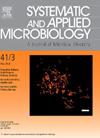A chemotaxonomic and phylogenomic re-evaluation of the genus Alicyclobacillus: A proposal for reclassification of about half of the species into the new genus, Paenalicyclobacillus gen. nov., with an emended description of the genus Alicyclobacillus, and recognition that the names Alicyclobacillus tengchongensis and Alicyclobacillus montanus are later heterotypic synonyms of Alicyclobacillus tolerans
IF 4.2
2区 生物学
Q2 BIOTECHNOLOGY & APPLIED MICROBIOLOGY
引用次数: 0
Abstract
The genus Alicyclobacillus represents a group of mostly acidophilic, meso-thermophilic bacteria, which obtained their name through the biosynthesis of uncommon, alicyclic fatty acids (FAs), i.e., ω-cyclohexyl or ω-cycloheptyl FAs. However, there are also species belonging to this genus that do not possess this trait. In addition, the difference of up to 9 % of the 16S rRNA gene sequences of 33 type strains compared with the first isolated type species, A. acidocaldarius DSM 446T, exceeds the 5.5 % threshold, which is typically used for the demarcation of a genus. This suggested that the taxonomy of the genus required a re-examination. We performed a phylogenomic and chemotaxonomic survey of the genus Alicyclobacillus. Phylogenetic trees based on the 16S rRNA gene and comparison of whole proteomes reconstructed from their genomes reveal that the genus Alicyclobacillus is reflected by two distinct clades; one represented by 14 type strains with a >94.1 % 16S rRNA gene similarity to A. acidocaldarius DSM 446T, and a second clade (composed of 14 type strains including A. cycloheptanicus) with a similarity of 91–94 %. This distinction fits well with their reported ability to produce alicyclic FAs, also revealed by the detection of two putative biosynthetic gene clusters (BGC) encoding their biosynthetic pathway in their genomes. The first BGC is responsible for the production of cyclohexane carboxylic acid-CoA and comprises five genes encoding proteins acting as an adjusted side branch of the shikimate pathway. The putative second BGC, responsible for production of cycloheptane carboxylic acid-CoA, comprises six genes encoding proteins acting as a side branch of the catabolic phenylacetic acid pathway. All Alicyclobacillus species of the first clade produce ω-cyclohexyl FAs and their genomes possess the corresponding BGC. In the second cluster, some species produce ω-cyclohexyl FAs, some produce ω-cycloheptyl FAs, whilst quite some members are not producing any alicyclic FAs. This corresponds to the presence or absence of the two BGCs in their genomes. We propose to reclassify all species of the second clade as members of a new genus, Paenalicyclobacillus gen. nov. and show that both Alicyclobacillus tengchongensis and Alicyclobacillus montanus are later heterotypic synonyms of Alicyclobacillus tolerans.
对aliicyclobacillus属的化学分类学和系统基因组学的重新评价:建议将大约一半的物种重新分类为新属Paenalicyclobacillus gen. nov.,并对aliicyclobacillus属的描述进行了修订,并认识到tenchongensis和montanus这两个名称后来是aliicyclobacillus tolerans的异型同义词
脂环杆菌属是一类嗜酸中嗜热细菌,因生物合成不常见的脂环脂肪酸(ω-环己基脂肪酸或ω-环庚基脂肪酸)而得名。然而,也有属于这个属的物种不具有这种特征。此外,33株型菌株的16S rRNA基因序列与首次分离的a . acidocaldarius DSM 446T型种相比,差异高达9%,超过了通常用于划分属的5.5%阈值。这表明该属的分类学需要重新研究。我们对酸环杆菌属进行了系统基因组学和化学分类调查。基于16S rRNA基因的系统发育树和从它们的基因组中重建的全蛋白质组的比较表明,酸环杆菌属由两个不同的分支反映;第一个分支由14个类型菌株组成,其16S rRNA基因与酸枝拟南蝽DSM 446T相似度为94.1%;第二个分支由包括环heptanicus在内的14个类型菌株组成,其相似度为91 ~ 94%。这种差异与报道的它们产生脂环脂肪酸的能力相吻合,这也被检测到两个假定的生物合成基因簇(BGC)在它们的基因组中编码它们的生物合成途径。第一个BGC负责产生环己烷羧酸辅酶a,包括5个基因编码蛋白质,作为莽草酸途径的一个调节侧分支。假定的第二个BGC,负责生产环庚烷羧酸-辅酶a,包含6个基因编码蛋白质,作为分解代谢苯乙酸途径的侧分支。第一支系的所有菌种均产生ω-环己基脂肪酸,其基因组具有相应的BGC。在第二簇中,一些物种产生ω-环己基脂肪酸,一些产生ω-环庚基脂肪酸,而相当多的成员不产生任何脂环脂肪酸。这与他们的基因组中是否存在这两种bgc相对应。我们建议将第二枝的所有种重新分类为一个新属——拟青环杆菌属(Paenalicyclobacillus gen. 11 .)的成员,并表明tenchongensis和montanus都是后来异型同源的aliicyclobacillus tolerans。
本文章由计算机程序翻译,如有差异,请以英文原文为准。
求助全文
约1分钟内获得全文
求助全文
来源期刊

Systematic and applied microbiology
生物-生物工程与应用微生物
CiteScore
7.50
自引率
5.90%
发文量
57
审稿时长
22 days
期刊介绍:
Systematic and Applied Microbiology deals with various aspects of microbial diversity and systematics of prokaryotes. It focuses on Bacteria and Archaea; eukaryotic microorganisms will only be considered in rare cases. The journal perceives a broad understanding of microbial diversity and encourages the submission of manuscripts from the following branches of microbiology:
 求助内容:
求助内容: 应助结果提醒方式:
应助结果提醒方式:


